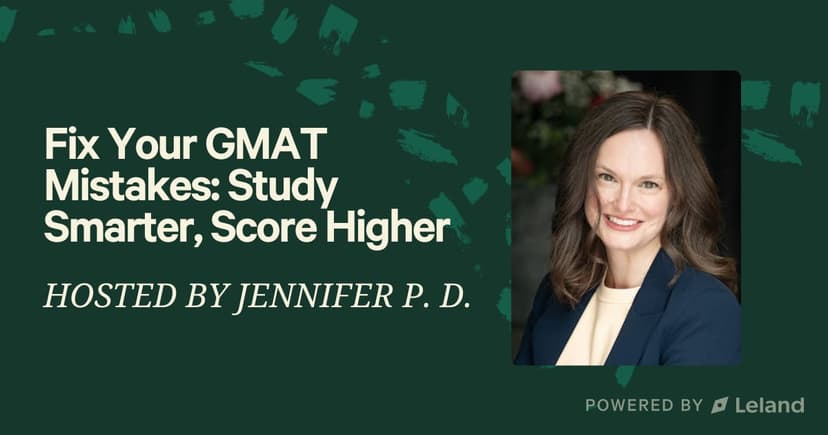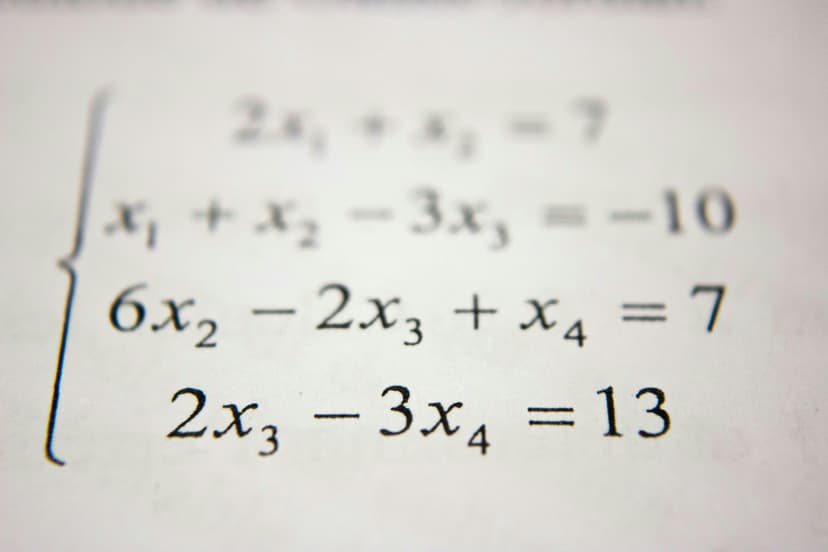GMAT Focus Edition: The Ultimate Guide (2025)
Master the new GMAT Focus with expert strategies, section breakdowns, and real-world prep tips to boost your score and stand out to business schools.

By Mihir G.
Custom GMAT Strategy | 765 Score (100th Percentile) | Chicago Booth Admit
Posted June 13, 2025

Join a free event
Learn from top coaches and industry experts in live, interactive sessions you can join for free.
Table of Contents
The GMAT Focus Edition is not just a refresh of the classic GMAT but a complete overhaul by the Graduate Management Admission Council (GMAC), designed to align more closely with the skills needed in today’s graduate management programs. Speaking as an experienced GMAT Focus Edition tutor, I can tell you: If you're a serious applicant to business school, this new version of the GMAT changes how you study, how you're scored, and even how you approach the test day experience.
In this guide, I’ll cover all the major changes to the exam structure, key prep strategies for the new Data Insights section, real-world recommendations from high scorers, and tips to boost your GMAT scores using detailed performance insights.
Read: 3 Things You Need to Know About the New GMAT Focus Edition
What Is the GMAT Focus Edition?
The new GMAT Focus Edition is a new exam launched by GMAC to replace the classic GMAT starting in 2024. It is shorter, more flexible, and places heavier emphasis on data analysis skills, verbal reasoning skills, and quantitative reasoning skills. The analytical writing assessment (AWA) is gone, and the scoring has been redesigned.
Key GMAT Focus Features:
- Total test time: 2 hours and 15 minutes
- Three sections: Quantitative Reasoning, Verbal Reasoning, Data Insights
- Ability to review as many questions as you want and change up to three answers per section
- Flexible section order selection
- A completely restructured score report system
This adaptive exam is now streamlined for test takers aiming to demonstrate business skills relevant to modern programs.
Read: GMAT Focus Edition: What You Need to Know and How Long is the GMAT (Focus Edition)? Breakdown by Section & Total
GMAT Focus Edition Section Breakdown
| Section | What It Tests | Format and Structure | Key Concepts Covered | Why It Matters |
|---|---|---|---|---|
| Quantitative Reasoning | This section measures your ability to reason quantitatively, solve math problems, and evaluate numerical data. It emphasizes logical thinking and data sufficiency over formula memorization. | You will have 45 minutes to answer 21 multiple-choice questions. There is no calculator allowed, and there are no geometry or coordinate plane geometry questions included. All problems test your ability to think critically under time constraints. | Topics include arithmetic, algebra, and word problems, with no data sufficiency problems. These have been moved to the new Data Insights section.. | Business schools value this section because it reveals how well you think through numbers, analyze constraints, and make logical decisions—core skills in finance, strategy, and analytics-heavy roles. |
| Verbal Reasoning | This section assesses your ability to read and understand complex material, evaluate arguments, and draw inferences. It focuses entirely on logical analysis and language comprehension. | You will have 45 minutes to answer 23 multiple-choice questions. The section includes reading comprehension and critical reasoning, with no sentence correction questions. This is a major shift from the classic GMAT. | Key concepts include understanding the structure of arguments, identifying assumptions, distinguishing between facts and opinions, interpreting passage meaning, and assessing the strength or flaws of arguments. | The section tests your ability to process written business information, interpret intentions, and make evidence-based conclusions—skills that are critical in leadership, consulting, and communication-intensive roles. |
| Data Insights | This section evaluates your ability to interpret, integrate, and reason through data presented in different formats. It is designed to reflect real-world, data-driven business challenges. | You will have 45 minutes to answer 20 questions. An on-screen calculator is provided for this section. You can review and edit up to three answers. The section draws on multiple formats, such as graphs, tables, and text sources. | This section includes graphics interpretation, table analysis, multi-source reasoning, two-part analysis, and traditional data sufficiency. Some questions may ask you to select up to three answers, especially when comparing multiple variables or sources. | This is the most distinctive and modernized part of the GMAT Focus Edition. Business schools consider it highly relevant for judging candidates’ ability to make informed decisions using complex, messy, and incomplete datasets, as is often required in management settings |
Additional Notes
The GMAT Focus Edition is a computer-adaptive exam, meaning each section changes in difficulty based on how well you're performing. Early questions matter more, so starting strong is critical. Unlike the classic GMAT, this version allows you to review and change up to three responses per section, giving you slightly more flexibility. However, once you submit a section, you cannot go back to it. That makes time management, pacing, and smart decision-making essential to optimizing your score.
Many business schools consider this section critical for assessing a candidate’s ability to handle complex data and make informed decisions.
Read: GMAT Focus Score Chart With Percentiles
What Changed Compared to the Classic GMAT?
| Feature | Classic GMAT | GMAT Focus Edition |
|---|---|---|
| Sections | 4 (including AWA & IR) | 3 |
| Total Questions | 80 | 64 |
| Time | 3 hours, 7 minutes | 2 hours, 15 minutes |
| Section Review | No | Yes (edit up to three answers) |
| Essay | Yes (AWA) | No |
| Score Range | 200-800 | 205-805 (new scale) |
GMAC also introduced a newly calibrated digital scoring algorithm. Each section contributes equally to your overall score.
What You Actually Get From Score Reports and How to Use It Strategically
The GMAT Focus Edition offers a major upgrade in score reporting, giving you deeper, more actionable insights than the classic GMAT ever did. Here’s what your official score report includes — and how serious applicants use it to optimize their admissions strategy:
What's included:
- A total score on a new 205–805 scale, with equal contribution from all three sections
- Individual section scores for Quantitative Reasoning, Verbal Reasoning, and Data Insights
- Percentile rankings for both total and section scores, showing how you stack up against other test takers
- Detailed performance breakdowns by question type (e.g., data sufficiency, multi-source reasoning), time spent per question, and accuracy
- The ability to send additional score reports to more schools (for a fee)
Expert Tip: Top scorers study the section analytics to guide their next move. If your Data Insights score lags, that’s a signal to shift prep time to graphics interpretation and multi-source reasoning. If Verbal Reasoning is your weak spot, focusing on inference-based reading can yield quick returns.
Best Resources for the GMAT Focus Edition (Battle-Tested)
| Resource | Best For |
|---|---|
| GMAT Official Guide 2025 | Reliable foundation, especially for verbal and quantitative basics |
| GMAT Focus Edition eBooks | Deep dives into Data Insights and Critical Reasoning |
| TTP (Target Test Prep) Quant | Intensive Data Sufficiency and Quantitative Reasoning Practice |
| 700+ Verbal Question Bank | Targeted prep for critical reasoning and reading comprehension |
Tactical Prep Strategies That Actually Work
- Start with Data Sufficiency and Data Insights. These sections are logic-heavy and unfamiliar to most test takers. Build fluency early so you're not cramming late.
- Simulate the “3-edit rule.” Use mock tests that allow you to review and change up to three answers per section, just like on the real GMAT exam. This will sharpen your judgment under time pressure.
- Drill modern question types. Focus on graphics interpretation, table analysis, and multi-source reasoning. You’ll need to compare information across tabs, sources, or layers of data, just like in business school.
- Ignore outdated content. The classic GMAT exam had geometry, sentence correction, and awkward essay prompts. The Focus Edition doesn’t. Don’t waste hours on irrelevant material.
- Build test-day logic, not just knowledge. You’re being tested on in-demand skills like decision-making with incomplete data, interpreting visuals, and drawing logical conclusions — not rote memorization.
What to Know About Testing Logistics
- Test Format Options: Take the GMAT Focus either at a test center or online via remote proctoring. Both options are equally accepted by business schools.
- Scheduling: You can book your test date up to 6 months in advance. Rescheduling and cancellations are allowed, but may incur fees depending on timing.
- Calculator Use: An on-screen calculator is available only during the Data Insights section. You will not be allowed to use a calculator during Quantitative Reasoning.
- Score Reporting Timeline: You’ll see an unofficial score preview immediately after the test. Your official score report is typically available within 3–5 business days, and may take up to 20 business days in some cases.
- Retake Policy: You can retake the GMAT Focus once every 16 calendar days, up to 5 times per year, and 8 times total in your lifetime.
- Online Test Requirements: If testing from home, you must have a quiet, private space, a clean desk, and a stable internet connection. GMAC will conduct a room scan and verify your ID before the GMAT exam starts.
- ID Requirements: A valid, government-issued photo ID is required, and your name must match exactly with your GMAT registration.
Why the GMAT Focus Edition is Important for Your MBA or Master’s
If you're serious about business school, the GMAT Focus Edition is the test built specifically for that goal. Unlike the GRE, which was designed for general graduate programs, the GMAT Focus sends a clear message: you’re prepared for the demands of a management education.
Top programs like the M7 still strongly prefer the GMAT, and with the new Focus Edition, your score says more than ever. Schools aren’t just looking at your total — they’re reviewing your performance in skills that matter: data analysis, critical reasoning, and decision-making.
Whether you're applying to elite MBA programs or strong regional business schools, this exam gives you a targeted, strategic advantage. It shows you’re not just test-ready — you’re business-ready.
Final Thoughts
The new GMAT is built to be faster, smarter, and more focused. With fewer sections but greater complexity, especially in data insights, it demands prep strategies that match its format.
If you want to succeed, build a prep plan around:
- Mastering the GMAT exam structure
- Understanding the skills needed for modern business
- Practicing with updated materials tailored to this focus edition
Don’t just aim to pass. Aim to understand what the GMAT Focus Edition is trying to test: how well you think, how you process data, and how you solve complex problems under pressure.
Ready to Maximize Your Score? Work with a Coach Who’s Done It.
If you’re aiming for a top-tier GMAT score, you don’t need to go it alone. I’ve helped dozens of students boost their scores by focusing on exactly what the test rewards: logic, precision, and pattern recognition.
As one of my students put it, “tutors who can explain the answer to one problem are a dime a dozen. Mihir has an uncanny ability to understand and address the gaps in your understanding and prescribe specific test-taking strategies that work for you, so you never miss another problem like it.”
Whether you’re stuck on sentence correction, data sufficiency, or just want a clear, proven plan, I can help. Let’s work together to make sure every hour you study actually moves the needle.
Book a free intro call and let’s create a custom plan, or check out my student success stories to see what’s possible
Read these next:
- How Late Can You Take the GMAT/GRE for MBA Applications?
- 3 Month GMAT Study Plan: Prepare for Success
- GMAT Verbal Guide: Reading Comprehension Questions
- Top 50+ Free Resources for GMAT & GRE Practice
- Average GMAT Score by School: Business Schools Ranking
GMAT Focus Edition – FAQs
Is the GMAT Focus Edition easier or harder than the previous version?
- The GMAT Focus Edition isn't necessarily easier or harder; it's different. It emphasizes skills like data interpretation and critical reasoning, removing sections like Sentence Correction and the Analytical Writing Assessment. The shorter duration (2 hours and 15 minutes) may reduce fatigue, but requires sharper time management.
How long are GMAT Focus Edition scores valid?
- GMAT Focus Edition scores are valid for five years from the test date, similar to the previous GMAT version.
Can I take the GMAT Focus Edition more than once?
- Yes, you can take the GMAT Focus Edition up to five times in a rolling 12-month period and no more than eight times in total. There must be at least 16 days between attempts.
Are all sections of the GMAT Focus Edition equally weighted in the total score?
- Yes, each of the three sections—Quantitative Reasoning, Verbal Reasoning, and Data Insights—contributes equally to the total score, which ranges from 205 to 805.
Will business schools still accept scores from the previous GMAT version?
- Yes, business schools will continue to accept scores from the previous GMAT version as long as they are within the five-year validity period.

Written by Mihir
5.0
(20)
Mihir has helped clients get into organizations like:
Browse hundreds of expert coaches
Leland coaches have helped thousands of people achieve their goals. A dedicated mentor can make all the difference.















